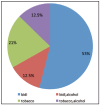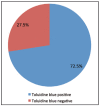Toluidine blue staining as an adjunctive tool for early diagnosis of dysplastic changes in the oral mucosa
- PMID: 24455079
- PMCID: PMC3892241
- DOI: 10.4317/jced.51121
Toluidine blue staining as an adjunctive tool for early diagnosis of dysplastic changes in the oral mucosa
Abstract
Prognosis of oropharyngeal squamous cell carcinoma depends on early diagnosis, despite advanced surgical techniques, the 5-year survival rate remains ~40-50%. Unfortunately, it is usually detected when it becomes symptomatic. This requires treatment which gives rise to a high rate of morbidity and mortality and, furthermore, early detection of oro-pharyngeal pre-malignant lesions is important to improve the survival rate and quality of life. Since dysplasia and in situ carcinoma contain much more DNA and RNA than the normal surrounding epithelium, the use of in vivo staining, by means of toluidine blue dye, is based on the fact that it is an acidophilic dye that selectively stains acidic tissue components such as DNA and RNA. Toluidine blue staining is considered to be sensitive in identifying early oro-pharyngeal premalignant and malignant lesions. In the present study, the use of toluidine blue staining was taken into consideration to identify clinically doubtful oro-pharyngeal lesions and to compare toluidine blue stain and with the histological evaluation. Key words:Early detection, improved survival, pre-cancer, toluidine blue, vital staining.
Conflict of interest statement
Figures
Similar articles
-
Toluidine Blue Staining in Identification of a Biopsy Site in Potentially Malignant Lesions: A Case-control Study.Asia Pac J Oncol Nurs. 2017 Oct-Dec;4(4):356-360. doi: 10.4103/apjon.apjon_38_17. Asia Pac J Oncol Nurs. 2017. PMID: 28966966 Free PMC article.
-
A study to evaluate the efficacy of toluidine blue and cytology in detecting oral cancer and dysplastic lesions.Quintessence Int. 2012 Jan;43(1):51-9. Quintessence Int. 2012. PMID: 22259809
-
Role of Toluidine Blue Staining in Suspicious Lesions of Oral Cavity and Oropharynx.Indian J Otolaryngol Head Neck Surg. 2019 Oct;71(Suppl 1):142-146. doi: 10.1007/s12070-017-1161-y. Epub 2017 Jul 20. Indian J Otolaryngol Head Neck Surg. 2019. PMID: 31741949 Free PMC article.
-
Diagnostic modalities for squamous cell carcinoma: an extensive review of literature-considering toluidine blue as a useful adjunct.J Maxillofac Oral Surg. 2015 Jun;14(2):188-200. doi: 10.1007/s12663-014-0660-6. Epub 2014 Jul 29. J Maxillofac Oral Surg. 2015. PMID: 26028834 Free PMC article. Review.
-
Toluidine blue and Lugol's iodine application in the assessment of oral malignant disease and lesions at risk of malignancy.J Oral Pathol Med. 1992 Apr;21(4):160-3. doi: 10.1111/j.1600-0714.1992.tb00094.x. J Oral Pathol Med. 1992. PMID: 1376363 Review.
Cited by
-
Evaluation of the Role of Toluidine Blue Paint as an Adjunctive Method to Biopsy in Suspicious Oral Lesion: A Hospital Based Study.Indian J Otolaryngol Head Neck Surg. 2022 Oct;74(Suppl 2):2458-2465. doi: 10.1007/s12070-020-02165-5. Epub 2020 Oct 19. Indian J Otolaryngol Head Neck Surg. 2022. PMID: 36452692 Free PMC article.
-
The salivary metatranscriptome as an accurate diagnostic indicator of oral cancer.NPJ Genom Med. 2021 Dec 8;6(1):105. doi: 10.1038/s41525-021-00257-x. NPJ Genom Med. 2021. PMID: 34880265 Free PMC article.
-
Non-invasive visual tools for diagnosis of oral cancer and dysplasia: A systematic review.Med Oral Patol Oral Cir Bucal. 2016 May 1;21(3):e305-15. doi: 10.4317/medoral.20996. Med Oral Patol Oral Cir Bucal. 2016. PMID: 26946204 Free PMC article.
-
A Study of Toluidine Blue Staining in Suspected Oral Malignancies in Patients Presenting to Tertiary Care Hospital in Central India.Indian J Otolaryngol Head Neck Surg. 2019 Dec;71(4):492-497. doi: 10.1007/s12070-019-01672-4. Epub 2019 May 14. Indian J Otolaryngol Head Neck Surg. 2019. PMID: 31750109 Free PMC article.
-
Toluidine Blue Staining in Identification of a Biopsy Site in Potentially Malignant Lesions: A Case-control Study.Asia Pac J Oncol Nurs. 2017 Oct-Dec;4(4):356-360. doi: 10.4103/apjon.apjon_38_17. Asia Pac J Oncol Nurs. 2017. PMID: 28966966 Free PMC article.
References
-
- Mehrotra R, Singh M, Thomas S, Nair P, Pandya S, Nigam NS. A cross-sectional study evaluating chemiluminescence and autofluorescence in the detection of clinically innocuous precancerous and cancerous oral lesions. J Am Dent Assoc. 2010;141:151–6. - PubMed
-
- Yeole BB, Sankaranarayanan R, Sunny MScL, Swaminathan R, Parkin DM. Survival from head and neck cancer in Mumbai (Bombay), India. Cancer. 2000;89:437–44. - PubMed
-
- Patton LL, Epstein JB, Kerr AR. Adjunctive techniques for oral cancer examination and lesion diagnosis: a systematic review of the literature. J Am Dent Assoc. 2008;139:896–905. - PubMed
LinkOut - more resources
Full Text Sources
Other Literature Sources



